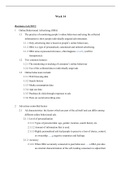Span
Development
by
John
W.
Santrock
(18th
Edition)
Chapter
2:
Biological
Beginnings
Evolutionary
Perspective
●
Natural
Selection
:
the
evolutionary
process
by
which
individuals
of
a
species
that
are
BEST
adapted
are
the
individuals
that
survive
and
have
the
BEST
(most
fit)
offspring.
●
Darwin
:
Those
that
survive
and
reproduce
pass
on
their
characteristics
to
the
next
generation,
thus,
better
adapted
to
the
world.
●
Adaptive
behavior:
behavior
that
promotes
an
organism’s
survival
in
its
natural
habitat
○
Organisms
must
adapt
to
places,
climates,
food,
and
ways
of
life.
●
Evolutionary
Psychology
=
Emphasizes
the
importance
of
adaptation,
reproduction,
and
“survival
of
the
fittest”
in
shaping
behavior.
○
“Fit”
is
the
ability
to
bear
offspring
that
survive
long
enough
to
bear
their
own
offspring.
Natural
selection
favors
behaviors
that
increase
reproductive
success.
●
David
Buss
:
Evolution
influences
psychological
aspects
such
as
how
we
make
decisions,
how
aggressive
we
are,
our
fears,
and
our
mating
patterns.
●
Extended
childhood
:
A
longer
childhood
may
have
evolved
due
to
humans
requiring
more
time
to
develop
a
large
brain
and
learn
the
complexities
of
human
society.
●
Swiss
Army
Knife
theory:
The
human
mind
encompasses
a
number
of
independent
domains
or
tools,
like
a
Swiss
army
knife.
●
Why
do
humans
live
so
long
after
reproduction?
:
Older
people/grandparents
are
needed
to
help
care
for
the
young
while
parents
are
out
working
for
food.
●
Paul
Baltes:
Selection
primarily
operates
during
the
first
half
of
life.
●
Evaluating
Evolutionary
Psychology:
The
evolutionary
perspective
is
one-sided,
does
not
value
social/environmental
factors,
relies
on
after-the-fact
explanations,
and
can’t
be
scientifically
tested.
●
Evolution
does
not
dictate
behavior!
Genetic
Foundations
of
Development
●
Chromosomes
:
Threadlike
structures
that
come
in
23
pairs,
with
one
member
of
each
pair
coming
from
each
parent.
Chromosomes
contain
the
genetic
substance
DNA.
●
DNA
:
A
complex
molecule
that
contains
genetic
information
●
Genes
:
Units
of
hereditary
information
composed
of
DNA.
Genes
help
cells
to
reproduce
themselves
and
help
manufacture
the
proteins
that
maintain
life. ○
Each
gene
has
its
open
place
on
a
particular
chromosome
○
Human
Genome
Project:
map
the
human
genome,
30,000
genes
○
Genomes
consist
of
many
genes
that
collaborate
with
each
other
and
with
nongenetic
factors
inside
and
outside
the
body.
○
Gene
expression
is
affected
by
the
environment
(for
example:
sleep
deprivation
causes
inflammation)
●
Methylation
:
tiny
molecules
attach
themselves
to
the
outside
of
a
gene
(makes
a
gene
more
or
less
capable
of
responding
to
biochemical
signals
from
the
body).
Genes
and
Chromosomes
●
Mitosis:
Cellular
reproduction
in
which
the
cell’s
nucleus
duplicates
itself
with
two
new
cells
being
formed,
each
containing
the
same
DNA
as
the
parent
cell,
arranged
in
the
same
23
pairs
of
chromosomes.
●
Meiosis
:
A
specialized
form
of
cell
division
that
occurs
to
form
eggs
and
sperm
(also
known
as
gametes).
●
Fertilization:
a
stage
in
reproduction
when
an
egg
and
a
sperm
fuse
to
create
a
single
cell,
called
a
zygote.
●
Zygote:
A
single
cell
formed
through
fertilization.
●
Sources
of
variability
:
○
Chromosomes
in
the
zygote
are
not
exact
copies
of
those
in
the
mother's
ovaries
or
the
father’s
testes
=
a
unique
combination
of
genes
●
Monozygotic
(Identical
Twins):
develop
from
a
single
zygote
that
splits
into
two
genetically
identical
replicas.
●
Dizygotic
(fraternal
twins):
develop
when
two
eggs
are
fertilized
by
different
sperm,
which
creates
two
zygotes
that
are
no
more
genetically
similar
than
siblings.
●
Mutated
gene:
a
permanently
altered
segment
of
DNA
●
Susceptibility
genes
:
those
that
make
the
individual
more
vulnerable
to
accelerated
aging
and
the
development
of
specific
diseases.
●
Longevity
genes:
those
that
make
the
individual
less
vulnerable
to
certain
diseases
and
more
likely
to
live
to
an
older
age.
●
Genotype
:
A
person’s
genetic
heritage-
the
actual
genetic
material
●
Phenotype
:
The
way
an
individual’s
genotype
is
expressed
in
observed
and
measurable
characteristics.
(Example:
height,
weight,
hair
color,
personality,
and
intelligence).










